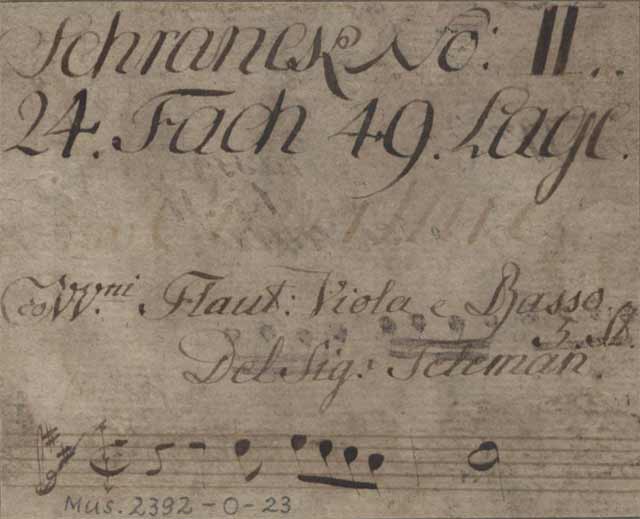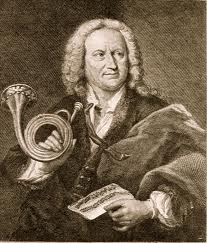
Baroque, Suite, Works
During his long and productive life (1681-1767), Telemann became one of the most celebrated of baroque composers. His output was vast, ranging from operas and cantatas to concertos and intimate chamber works.
One of his most charming pieces is the programmatic Don Quixote suite for strings and continuo. The suite opens conventionally enough, with a formal French-style baroque overture. The movements which follow, however, depict different scenes from the adventures of Don Quixote, Cervantes’ famous knight, and his squire, Sancho Panza.
It begins with the “Awakening of Don Quixote,” with string drones evoking sleep, followed immediately by the “attack on the Windmills,” with furiously rushing string passages. “Sighs for Princess Aline” features accented descending eighth notes characteristic of 18th-century passages evoking “tender” emotions. “Sancho Panza Swindled” has a rough peasant atmosphere, depicting the squire being tossed in a blanket. “Rosinante Galloping” evokes the smooth stride of Don Quixote’s horse, while “The Gallop of Sancho Panza’s Mule” shows the ungainly “start-stop” step of the squire’s transport. The Suite closes with “Don Quixote at Rest,” also featuring string drones.
20th Century, Suite, Works
Ravel first composed Tombeau as a suite for piano in six movements, and then arranged it as a 4-movement suite for orchestra in 1919.
A “tombeau” was, in the French baroque tradition, a composition meant as a memorial, and each movement of Ravel’s Tombeau is dedicated to a friend who perished in World War I.
The reference to “Couperin” evokes one of France’s great baroque composers, and indeed the four movements of this work are based largely on baroque French dance forms. Ravel’s genius is to fuse these baroque frameworks with modern harmonies and instrumentation to create works of atmosphere, charm and grace.
The opening Prélude is a cascade of motifs led by the oboe (which has a virtuosic part in this entire work). The dance movements all have main sections with contrasting interludes. The Forlane is a wistful modern rendering of a stately dance, evolving into ever more unearthly harmonies until its resolution; the Menuet is a charming updating of an old classic; and the Rigaudon, with woodwind and brass highlights, provides a rousing finale.
20th Century, Suite, Works
Appalachian Spring is undoubtedly one of Copland’s best-known works. It led to his receiving the Pulitzer Prize for music in 1945 and helped catapult him to popular fame.
Copland received a commission to compose the original version in 1943-44 as ballet music for Martha Graham, whose dance company premiered the work in 1944. He originally scored it for 13 instruments and called the piece “Ballet for Martha;” it was she, in fact, who gave it the title “Appalachian Spring” by which we now know it. In 1945 Copland revised the ballet into the full orchestral suite which we are performing today.
A programmatic piece, it describes a scene in Western Pennsylvania in the 1830s centering on a celebration around a pioneer family’s new farmhouse. It opens with a slow introduction to the characters, setting a serene, calm mood with echoing three-note rising themes in the winds. It abruptly shifts to a fast, lively section (opening with leaping octaves in the upper strings), with elated and religious thematic overtones brought out by the brass and winds. This is followed by a slow dance between the bride and her intended groom, full of tenderness and passion. Next, a revivalist and his flock appear; the music reflects folk themes and evokes square dances and country fiddles. A lively solo bride’s dance comes next, heralded by fast scale-like passages in the flutes and violins and then by the entire orchestra.
After a transition which echoes the opening themes, there follow a series of scenes of daily life with a theme and variations based on the Shaker melody “Simple Gifts.” After an inspiring climax, the strings and winds revert to quiet passages evoking contemplation and prayer. At the end of the piece, the pioneer couple are left “quiet and strong” in their new house.
Baroque, Suite, Works
The life of William Boyce (1711-1779) spanned the flowering of the baroque era through early classicism. Boyce was active in official London music circles, becoming Composer to the Chapel Royal in 1736 and Master of the King’s Musick in 1755.
He composed a number of symphonies, concerti grossi and overtures for various combinations of strings and winds (although his best-known work is the song “Heart of Oak” which he wrote for a theatrical pantomime).
He published his twelve overtures in 1770, still mostly in high baroque style. They are based largely on celebratory Odes for royal birthdays which Boyce was required to write as part of his official duties.
Overture No. 11 is based on the 1766 Birthday Ode and features strings, oboes, bassoon, trumpets and timpani. The trumpets and timpani play a prominent role, particularly in the formal introduction and the fugue which follows.
20th Century, Suite, Works
Many of Vaughan Williams’ compositions incorporate elements of folk music. This short suite was originally composed for a military band and is entirely based on English folk tunes – “Seventeen Come Sunday,” “My Bonny Boy,” and a set of folk songs from Somerset.
The suite was arranged for full orchestra by Gordon Jacobs, one of Vaughan Williams’ students and a composer in his own right. The orchestral arrangement received Vaughan Williams’ endorsement after its publication in 1924.
The two outer fast movements are sprightly, in march tempo. They evoke the British Empire at its martial zenith, with emphasis on brass and percussion. The middle movement is wistful and contemplative, with plaintive wind solos alternating with the strings.
Baroque, Suite, Works
When Charles II mounted the throne in 1660, one of his first acts was to lift the ban on theatrical performances, imposed by the Puritans during the Commonwealth years after the Civil War of 1642. Very soon, the ‘masque’ entertainment, involving music, spectacle, dance and drama, was again a thriving business.
Indeed, Purcell himself wrote incidental music (‘incidental’ as it was not part of the action, but occurred in the intermissions and interludes) for 43 plays in all. Several of these were preserved in the Orpheus Britannicus collection, thanks to which we still have many of these wonderful pieces today.
Although the original play of 1690 is now lost, these lovely dance movements remain, here orchestrated by another great English composer, Gustav Holst. They all display Purcell’s delight in harmonic pungency, wonderfully independent contrapuntal writing and endless inventiveness (the Jig is actually an ingenious arrangement of the popular tune Lilliburlero, with the melody in the bass).
20th Century, Suite, Works
Kodály, together with Bartok, was a major figure in the collection and analysis of Hungarian folk music. Many of his compositions are in fact based on Hungarian folk tunes of various types.
The “Marosszék Dances” were originally composed for piano and later arranged by Kodály for orchestra; its first performance took place in 1930. The themes contained in this work are based on 17th-century peasant tunes from various Hungarian provinces.
The opening theme, with its oriental-sounding harmonic minor motif, recurs in several forms during the work. The “dance” tunes are varied, lively and charming in tempo and feeling. They feature colorful effects from the wind instruments, unusual rhythms and vivid atmospheric effects.
The piece ends with a rousing coda and flourish from the brasses.
Baroque, Suite, Works
This Suite unites music from the dramatic output of Purcell. Barbirolli, the famous English conductor, took excerpts from “The Gordian Knot Untied,” “Dido and Aeneas” and “King Arthur” and re-orchestrated them slightly, mostly by giving the sung lines of arias to solo instruments.

Baroque, Suite, With Audio, Works
As part of his vast output of vocal and orchestral works, Bach wrote four orchestral suites (or “ouvertures”), probably between 1724 and 1739. They are based on the 18th-century “French style” of overture – a slow opening section with a faster middle section, followed by a variety of dance movements.
Bach’s Fourth Suite is brilliantly scored for trumpets, oboes, timpani and strings, and features all of these forces in its scope.
From the Performance of Fall, 2017.
It begins with a magnificent overture, followed by a lively fugue in 9/8 time showcasing Bach’s mastery of counterpoint, concluding with the stately opening procession.
The following four dance movements are diverse, each showcasing different sections of the orchestra. Trumpets, oboes and bassoon feature in the lively Bourrée and robust Gavotte; woodwinds and strings combine in an elegant Menuet, with a middle section scored for solo strings.
The Suite ends with a rousing Réjouissance (literally, rejoicing or celebration) featuring the entire ensemble.
Baroque, Suite, Works
Johann Pachelbel (1653-1706) was born in Nuremberg and served as court organist in a number of churches in central and southern Germany. He influenced many composers of his generation and later, including Johann Sebastian Bach.
Aside from his well-known Canon in D Major, Pachelbel wrote quite a few instrumental and keyboard works. The Suite in G Major is scored for 5 string parts (2 violins, 2 violas and continuo). It consists of a short, majestic overture with dynamic contrasts, followed by 5 dance movements.


